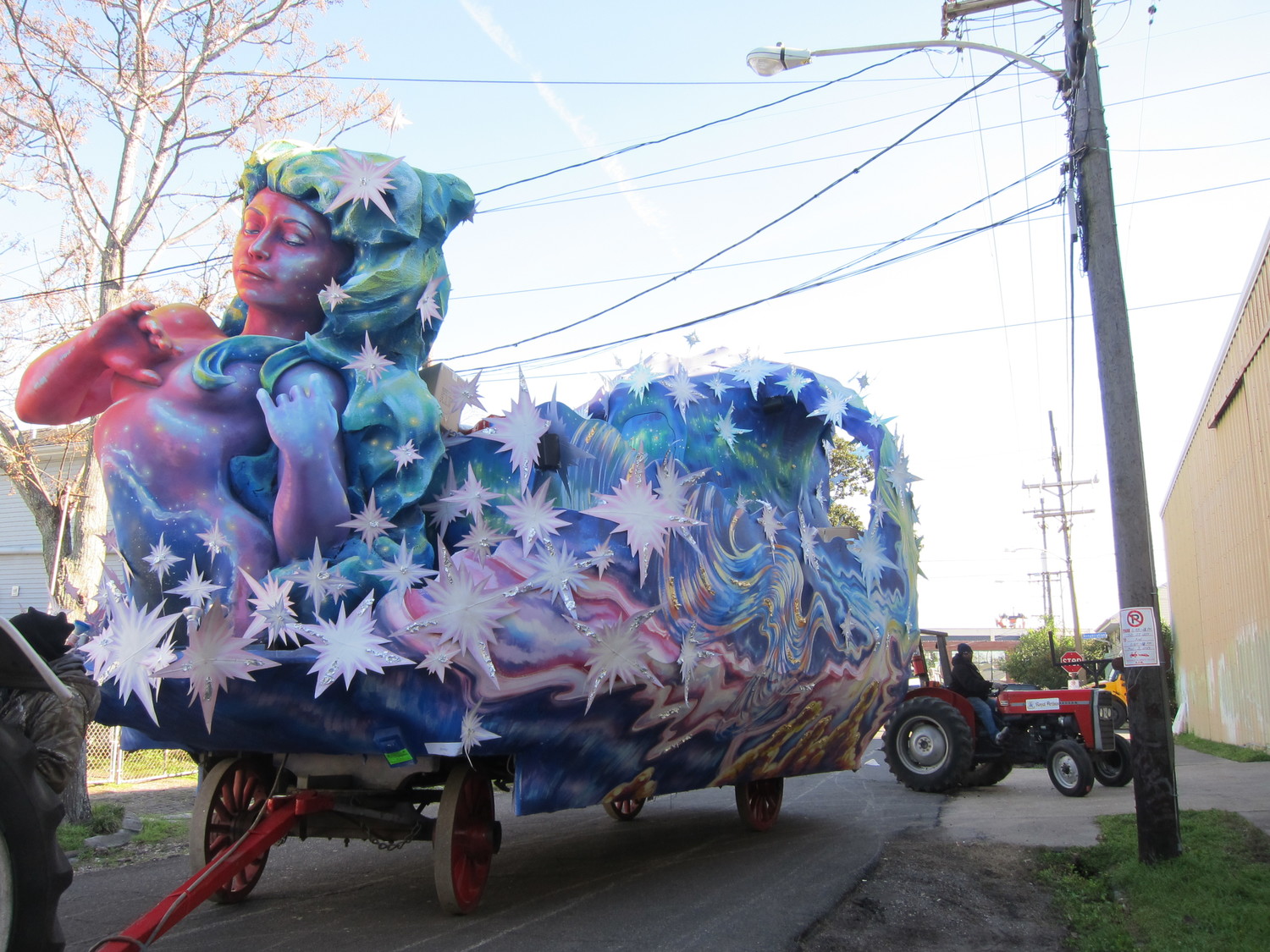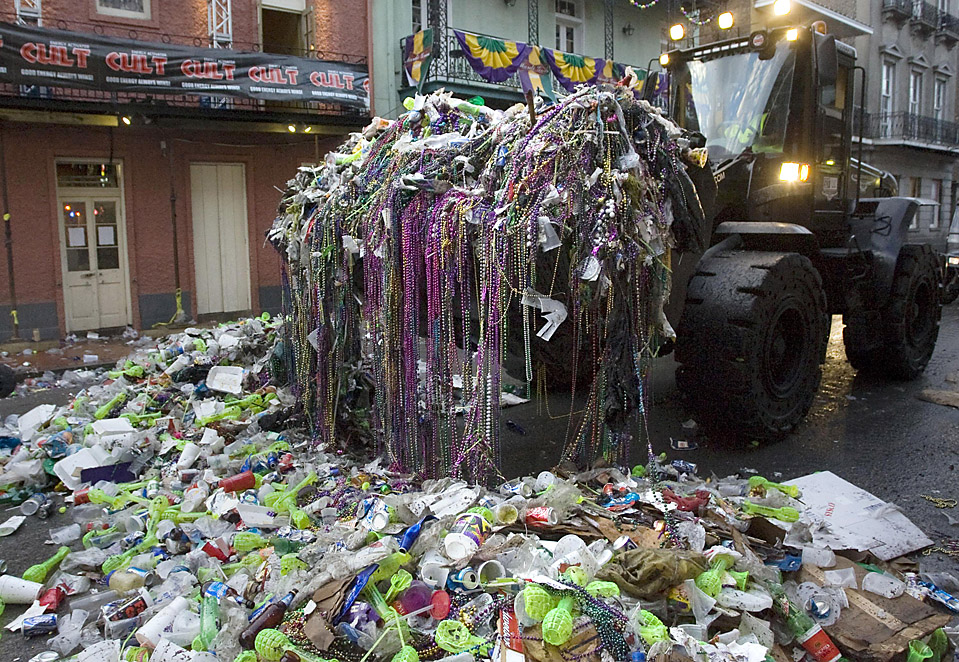Editor’s Note: To get us in the mood for Mardi Gras (who are we kidding, we’re all in the mood for Mardi Gras already), we are diving into the sugary, sensual, and silly side that makes this the most wonderful time of the year! This entire month we will be celebrating the food, the culture, the music, and the traditions of Mardi Gras for our “Craving some Carnival” series.
We love Carnival, and that also means that we want it to love the world we live in. As Danielle Heifetz shows, not all that glitters is gold.

A float designed by Thomas from the parade “Proteus” in 2014
There are a few lessons you learn immediately when you are experiencing Mardi Gras for the first time. The clear lesson #1 is, (And it will always be said with discerning emphasis) “Don’t pick beads up off the ground! it’s bad luck.”
I heard this nearly immediately my freshman year at Tulane University, standing on the concrete of a gas station on St. Charles Avenue, a safe 10 feet away from the cheering crowds manically waving their arms, batting their eyelashes, doing anything to secure plastic beads from the grips of the parade riders. From my distance, I was able to quickly make eye contact with a rider on the top tier of a float, who hurled a plastic green chain with a charm in my direction. I stuck out my arms and leaned forward to try and catch it.
It fell, unceremoniously, a foot from my face, and dropped onto the floor into a puddle of plastic.
Amidst the joy and celebration in the streets, the parades, the drinking spirit and the eagerness to catch a throw to take home, there are little reminders of what a celebration of excess amounts to in a 21st-century iteration. That cup you dropped on the ground with little hesitation reappears as a statistic: annually in New Orleans nearly 3.5 Million pounds of trash are produced during the ten peak days of Carnival (Heneghan, Can Mardi Gras Go Green?). That bead that slipped through your grasp reappears in the 93,000 tons of beads New Orleans took out of the sewer system in 2018 (Borunda, It’s Time to Rethink Mardi Gras-Without Tons of Plastic Beads).

Mardi Gras Trash Pickup (Photo: Wiki Commons)
Too many beads (which, in my opinion, are public enemy number one in terms of Mardi Gras waste) and other disposable items are being produced, which is incredibly expensive to the city and difficult to clean. During just the two-week height of Mardi Gras season in 2018, the city of New Orleans spent $1.5 million to collect 2.6 million pounds of trash. (Larino, Is a Plastic-Free Mardi Gras Possible?). And even if we do collect the beads, they are unable to be recycled and wind up in landfills. Most of the plastic waste from Mardi Gras is contaminated in some way and cannot be recycled. (Bullock, The Plastic Problem at Mardi Gras).
In addition, the toxins from the beads as well as all other Mardi Gras trash significantly impact the city’s ecology. It’s virtually impossible to track the trash that’s uncollected and passes through the drains into waterways. Despite this lack of data, we can see that there are high levels of lead throughout the city, with the majority of lead found in New Orleans’ soil being found directly alongside the Mardi Gras parade routes (Redmon, The Toxic Truth Behind Mardi Gras Beads). In addition, the Gulf contains one of the world’s highest concentrations of microplastics– “which are harmful bits of plastic 5 mm or less in diameter — about the size of a Mardi Gras bead” (Shepherd, Plastic Mardi Gras Beads Are Cheap, Fun To Throw). This is in no small part due to the excess of plastic New Orleans unintentionally seeped into the Mississippi River last year.
However, various grassroots efforts throughout the city show that a greener Mardi Gras is in reach and possible. Legislative progress has already begun to take effect, with the city banning the plastic bags that Krewe members used to throw multiple strands of beads in, which inevitably always wound up on the ground (Shepherd, Plastic Mardi Gras Beads Are Cheap, Fun To Throw).

Krewe of Chewbacchus Parade 2020, known for performance and handmade throws (photos by: Brandon Robert)
A huge concern that has prevented some of this legislative progress and a change in the Mardi Gras trends is the need to continue to Mardi Gras a profitable event for the city. But there are ways that both sustainability and profitability within the community can be met. Many Krewes have begun to ditch China-made beads to embrace throws sourced in Louisiana, such as glass beads from companies such as Atlas beads and biodegradable beads from companies such as Zombeads. A few Krewes have asked their members to eschew the beads in favor of throwing fewer but more sustainable items such as facemasks (The Krewe of Muses), hair ties, bicycle bells and oven mitts (The Krewe of Bacchus) (Larino, Is a Plastic-Free Mardi Gras Possible?). This has the effect of producing less waste, creating less trash to be dumped into landfills and causing less toxins to seep into New Orleans already-fragile soil.
There is also the work of nonprofits such as Arc of Greater New Orleans, which collects, repairs and reuses beads each year and sells them back to Krewes (Borunda, It’s Time to Rethink Mardi Gras-Without Tons of Plastic Beads). The Young Leadership Council (YLC) has developed its own Mardi Gras Recycling Program, distributing recycling containers for beads and other waste, as well as collection stations along the parade route. They then take the collected beads to Arc Nola to be reused. (Borunda, It’s Time to Rethink Mardi Gras-Without Tons of Plastic Beads) The YLC has partnered with the local community to create a Krewe called the “Trashformers” who walked in a few parades to pick up trash along the route (Larino, Is a Plastic-Free Mardi Gras Possible?). Arc Nola also created a “Throw ‘Em Back” float that rode with nearly every parade this year, asking riders to throw their unwanted beads back onto the float for easy collection (Shepherd, Plastic Mardi Gras Beads Are Cheap, Fun To Throw).
Many of these improvements are working to address the core of the issue of Mardi Gras production and waste–most of what is produced has no value to us. While the stuff we receive is fun, the ultimate change is going to have to be in the culture and mindset of Mardi Gras itself. The quantities of cheap beads we can amass are not, and cannot be a measure of a parade’s fun or success; the clear damage they cause far outweighs our momentary excitement
Mardi Gras is moving forward–with less stuff, for sure, returning to a celebration with more meaning and value to the community. In the true spirit of the city, all of these efforts are done with New Orleanians in mind and use the city’s upbeat spirit to demonstrate that preserving the city does not have to be a painstaking task. There is no doubt that a city that comes together to celebrate history and culture will continue to work together to go green.
——————-
Works Cited
“2018 Future of Mardi Gras Forum.” Urban Conservancy , 2018, www.urbanconservancy.org/wp-content/uploads/2018/11/Mardi-Gras-Forum-Report.pdf.
Borunda, Alejandra. “It’s Time to Rethink Mardi Gras-Without Tons of Plastic Beads.” National Geographic, 25 Feb. 2019, www.nationalgeographic.com/environment/2019/02/rethink-mardi-gras-without-plastic-beads/#close.
Bullock, Sybil. “The Plastic Problem at Mardi Gras.” Greenpeace USA, 17 Feb. 2018, www.greenpeace.org/usa/plastic-problem-mardi-gras/.
Heneghan, Carolyn. “Can Mardi Gras Go Green?” Earth Island Journal, Earth Island Institute , 2015, www.earthisland.org/journal/index.php/articles/entry/can_mardi_gras_go_green/.
Larino, Jennifer. “Is a Plastic-Free Mardi Gras Possible?” New Orleans, Very Local New Orleans, 27 Feb. 2020, nola.verylocal.com/is-a-plastic-free-mardi-gras-possible/123769/.
Redmon, David. Beads, Bodies, and Trash: Public Sex, Global Labor, and the Disposability of Mardi Gras. Routledge, 2015.
Redmon. “The Toxic Truth Behind Mardi Gras Beads.” Smithsonian.com, Smithsonian Institution, 8 Mar. 2017, www.smithsonianmag.com/science-nature/toxic-truth-mardi-gras-beads-180962431/.
Shepherd, Betsy. “Plastic Mardi Gras Beads Are Cheap, Fun To Throw – And Toxic For The Environment.” WWNO, www.wwno.org/post/plastic-mardi-gras-beads-are-cheap-fun-throw-and-toxic-environmen.
Weiss, Toni. “2014 Economic Impact Study.” Tulane Freeman School of Business, Feb. 2015, www2.tulane.edu/news/newwave/upload/2014-Mardi-Gras-Impact-Study.pdf.
 NOLAbeings
Multimedia artist Claire Bangser created NOLAbeings as a portrait-based story project that marries...
NOLAbeings
Multimedia artist Claire Bangser created NOLAbeings as a portrait-based story project that marries...
 Data corner: Adobe Suite (create a PDF, social media graphic, presentation, edit a photo and video
Data corner is where you go to work with analytics and top tech skills. It takes on everything from PERL and SQL to Canva and Sprout Social.
Data corner: Adobe Suite (create a PDF, social media graphic, presentation, edit a photo and video
Data corner is where you go to work with analytics and top tech skills. It takes on everything from PERL and SQL to Canva and Sprout Social.
